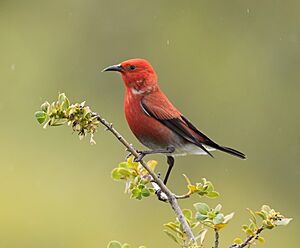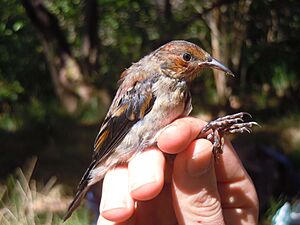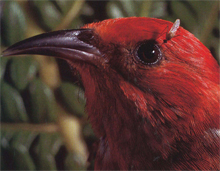ʻApapane facts for kids
Quick facts for kids ʻApapane |
|
|---|---|
 |
|
| 'Apapane on pilo | |
| Conservation status | |
| Scientific classification | |
| Genus: |
Himatione
|
| Species: |
sanguinea
|
| Subspecies | |
|
Himatione sanguinea sanguinea |
|
 |
|
The ʻapapane (AH-pah-PAH-nay) is a small, bright red bird. It is a type of Hawaiian honeycreeper. These birds live only in the Hawaiian Islands. They are the most common honeycreeper. You can find them on the islands of Hawaiʻi, Maui, Lānaʻi, Kauaʻi, Molokaʻi and Oʻahu.
ʻApapane birds often look for food in the tops of ʻōhiʻa trees. They drink nectar from the flowers. This helps the trees by spreading pollen. Ancient Hawaiians used red feathers from the 'apapane. They used them to decorate special capes (ʻahuʻula), helmets (mahiole), and feather leis (nā lei hulu) for their chiefs.
Contents
What Does an 'Apapane Look Like?
'Apapane birds are small. They grow to about 13 centimeters (5 inches) long. Males are a bit heavier than females. Males weigh about 16 grams (0.56 ounces). Females weigh around 14.4 grams (0.51 ounces).
Adult 'apapane are bright red all over. They have clear white feathers under their tail and on their lower belly. Their main wing and tail feathers are black. Young 'apapane are yellow-brown and gray. They have the same white belly feathers as adults. They change to their red color over two years. 'Apapane often hold their tails up. This shows off their white feathers.
'Apapane's Special Song
'Apapane are very active singers. They even sing while flying! Their calls and songs can be quite different. But they often repeat parts of their songs. They are known to sing from a branch for 10 to 30 seconds. Their song can include repeated squeaks, whistles, and trills. They also make raspy and clicking sounds.
What Do 'Apapane Eat?
'Apapane have special tongues. They are shaped like tubes with brush tips. Their beaks are curved downwards. These features help them drink nectar from flowers. They often visit ʻōhiʻa trees. They feed on the flowers in groups with other 'apapane. They also join groups with other bird species. They travel widely to find ʻōhiʻa trees that are blooming.
'Apapane also eat insects and spiders. They pick them off leaves and small branches in the treetops. They do not look for food on the ground. A study in 1953 looked at what 'apapane had eaten. Most had eaten butterflies and moths. Many had also eaten hoppers, lacewing larvae, and spiders. They also find food on other native trees. These include māmane, koa, naio, kōlea, alani, kanawao, koki'o ke'oke'o, and 'ōlapa.
'Apapane Life Cycle and Breeding
The breeding season for 'apapane starts in October or November. It is busiest between February and June. 'Apapane often build their nests on the end branches of ʻōhiʻa trees. Nests have also been found in tree holes and lava tubes. Some are built in the tops of koa, kāwaʻu, and hapuʻu tree ferns.
The female bird lays 1 to 4 eggs. She sits on them for 13 days to keep them warm. While she is incubating, the male does not visit the nest. But he will feed the female when she is away from the nest. The female does not sing or call from the nest. She finds her singing male and asks him for food. Once the eggs hatch, both parents feed the young birds. Young 'apapane depend on their parents for less than 4 months.
Where Do 'Apapane Live?
'Apapane live in native Hawaiian forests. These are often wet forests with lots of ʻōhiʻa and koa trees. They can be found in many places. Their numbers change as they move around. They often travel to find ʻōhiʻa trees that are flowering.
You can find 'apapane at lower elevations on most islands. However, most 'apapane live above 4,100 feet (1,250 meters). There are fewer mosquitoes at these higher places. This means there is less risk of diseases for the birds. 'Apapane live on the islands of Hawaiʻi, Maui, Kauaʻi, Molokaʻi, Oʻahu, and Lānaʻi. Their populations are steady. Experts say they are a species of "least concern." This means they are not currently at high risk of disappearing.
Threats and Conservation Efforts
'Apapane are the most common honeycreeper. They live in the largest area. There are more than 1.5 million of these birds. Most of them live on Hawaii and Maui Islands. The biggest dangers to 'apapane are losing their homes, diseases, and new animals brought to the islands.
'Apapane are found on all the main Hawaiian Islands except Niihau and Kaho’olawe. They mostly live at high elevations. This is where there is less bird malaria. Other threats include non-native animals. These are predators like mongooses, rats, and wild cats.
'Apapane can get avian malaria. This disease is carried by mosquitoes. They also can get Avian pox. This causes wart-like bumps on the bird. These diseases can make it hard for the bird to eat or see. 'Apapane are thought to help spread malaria. This is because they often move to lower areas where mosquitoes are common. Some 'apapane may be becoming resistant to malaria. This is good news for the species.
Today, there are no special actions just for 'apapane. But efforts to help rarer Hawaiian birds also help the 'apapane. Groups are setting up nature reserves to protect native forests. They build fences to keep out wild pigs, goats, and deer. This helps native plants grow back. It also restores homes for native birds.
A new threat is a fungus called Rapid ʻŌhiʻa Death (ROD). This disease can quickly kill ʻōhiʻa trees. These trees are a very important food source for 'apapane. Conservation groups are working hard to stop the spread of this disease.




